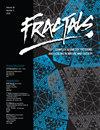氧化层分形维数对C/SiC复合材料被动氧化的影响
IF 2.9
3区 数学
Q1 MATHEMATICS, INTERDISCIPLINARY APPLICATIONS
Fractals-Complex Geometry Patterns and Scaling in Nature and Society
Pub Date : 2023-10-21
DOI:10.1142/s0218348x23501232
引用次数: 0
摘要
C/SiC复合材料在近空间高超声速环境中是一种很有前途的抗烧蚀热防护材料。通过被动氧化在复合材料表面形成sio2氧化层是影响其性能的重要因素。准确预测C/SiC复合材料在被动氧化过程中sio2氧化层的厚度、退变和质量损失是至关重要的。sio2氧化层是一种典型的具有自相似性的多孔介质,因此可以应用分形理论建立氧流量与氧化层微观结构参数之间的关系。采用Weierstrass-Mandelbrot (WM)函数模拟sio2氧化层与C/SiC复合材料之间的粗糙界面,评价氧化层分形维数对C/SiC复合材料热防护性能的影响。结果表明,当氧化层的弯曲度分形维数降低、孔面积分形维数增大时,C/SiC复合材料的热防护性能得到改善。相反,复合材料的抗烧蚀性能随着氧化层弯曲度分形维数的增大和孔隙面积分形维数的减小而增强。计算模型的预测结果与实验数据吻合较好,证明了氧化层微观结构参数对复合材料被动氧化的关键影响,为设计具有理想热防护或抗烧蚀性能的材料提供了实际意义。本文章由计算机程序翻译,如有差异,请以英文原文为准。
THE INFLUENCE OF FRACTAL DIMENSION OF OXIDE LAYER ON PASSIVE OXIDATION OF THE C/SiC COMPOSITE
The C/SiC composite is a promising material for ablation-resistant thermal protection in near-space hypersonic environments. The formation of an SiO 2 oxide layer through passive oxidation on the surface of the composite is a significant factor influencing its performance. It is essential to accurately predict the thickness of the SiO 2 oxide layer and the recession and mass loss of the C/SiC composite during passive oxidation. The SiO 2 oxide layer is a typical porous media exhibiting self-similarity and thus fractal theory can be applied to establish the relation between the oxygen flow rate and microstructural parameters of the oxide layer. The Weierstrass–Mandelbrot (WM) function is employed to simulate the rough interfaces between the SiO 2 oxide layer and the C/SiC composite to evaluate the influence of the fractal dimensions of the oxide layer on the performance of thermal protection of the C/SiC composite. The results show that the C/SiC composite exhibits improved thermal protection performance when accompanied by a lower tortuosity fractal dimension and a higher pore area fractal dimension of the oxide layer. Conversely, the composite demonstrates enhanced ablation resistance with a higher tortuosity fractal dimension and a lower pore area fractal dimension of the oxide layer. The predictions of the calculation model show good agreement with the experimental data and demonstrate the critical influence of microstructural parameters of the oxide layer on passive oxidation of the composite, providing practical implications for designing materials with desired thermal protection or ablation resistance properties.
求助全文
通过发布文献求助,成功后即可免费获取论文全文。
去求助
来源期刊
CiteScore
7.40
自引率
23.40%
发文量
319
审稿时长
>12 weeks
期刊介绍:
The investigation of phenomena involving complex geometry, patterns and scaling has gone through a spectacular development and applications in the past decades. For this relatively short time, geometrical and/or temporal scaling have been shown to represent the common aspects of many processes occurring in an unusually diverse range of fields including physics, mathematics, biology, chemistry, economics, engineering and technology, and human behavior. As a rule, the complex nature of a phenomenon is manifested in the underlying intricate geometry which in most of the cases can be described in terms of objects with non-integer (fractal) dimension. In other cases, the distribution of events in time or various other quantities show specific scaling behavior, thus providing a better understanding of the relevant factors determining the given processes.
Using fractal geometry and scaling as a language in the related theoretical, numerical and experimental investigations, it has been possible to get a deeper insight into previously intractable problems. Among many others, a better understanding of growth phenomena, turbulence, iterative functions, colloidal aggregation, biological pattern formation, stock markets and inhomogeneous materials has emerged through the application of such concepts as scale invariance, self-affinity and multifractality.
The main challenge of the journal devoted exclusively to the above kinds of phenomena lies in its interdisciplinary nature; it is our commitment to bring together the most recent developments in these fields so that a fruitful interaction of various approaches and scientific views on complex spatial and temporal behaviors in both nature and society could take place.

 求助内容:
求助内容: 应助结果提醒方式:
应助结果提醒方式:


